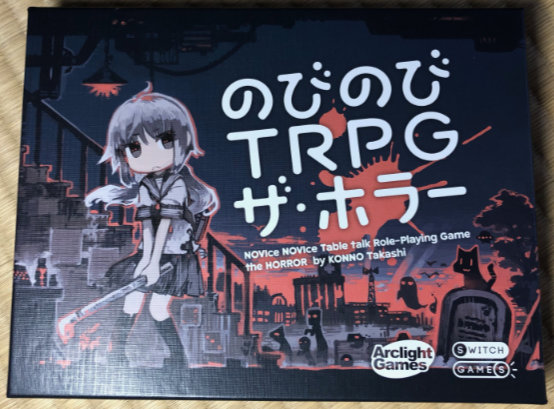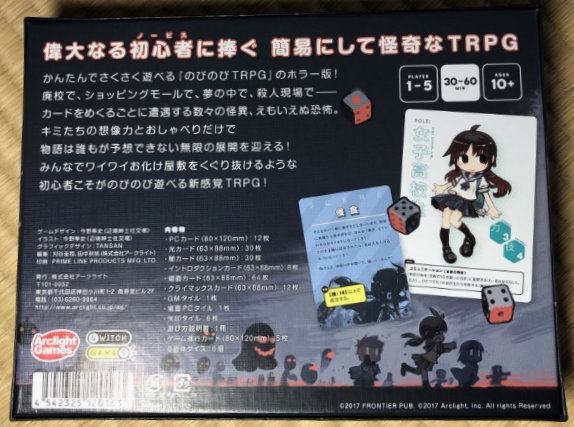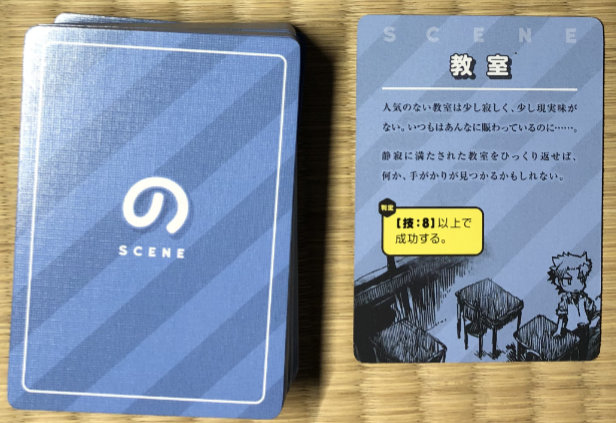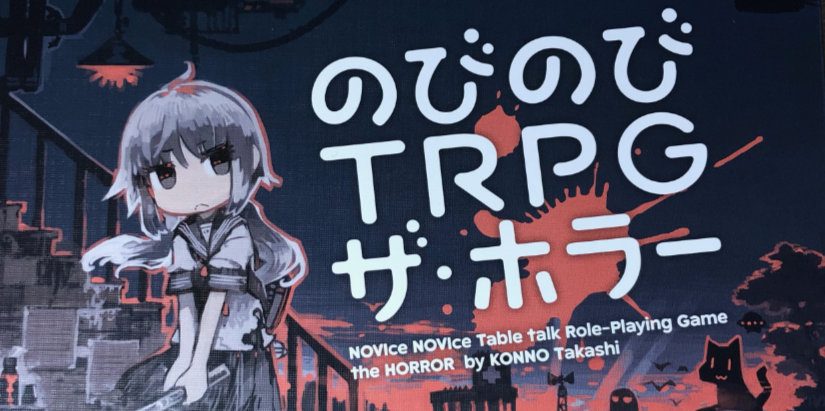

I had my eye on the “NoviNovi” TRPG games for a while before finally picking up “The Horror” edition at Tokyo Game Market. Created and illustrated by Takashi Konno, the original version that was self-published by the creator was a fantasy setting. It was picked up by Arclight Games and both horror and steampunk versions have been released. The subtitle explains the meaning behind the name: NOVIce NOVIce Table talk Role-Playing Game the HORROR. It’s a self-contained and easy to play TRPG that only takes thirty to sixty minutes, with everything you need to play in the box. No paper or pencils required.
Inside the Box

Coming in a 21.5cm x 16.5cm sturdy cardboard box, it contains several decks of cards, 12 larger character cards, tiles, six six-sided dice, and a small 15 page manual.
The card types are:
– Introduction cards
– Scene cards
– Light cards
– Darkness cards
– Climax cards
– Rules Reference cards
The manual combines normal rules with manga illustrating their point. One of the more interesting examples for me was the section about role playing. It described what role playing is and said that it’s ok to speak as your character would, but simply describing what they do is also fine. The two manga panels next to this section first showed an action-packed frame with the hero yelling that he’ll, “hold them back!” The second panel showed a player, saying “I’ll hold them back. I guess that works.” and responses from other players saying, “cool, that sounds good”. The emphasis is on both of these being valid play styles.

Interestingly, the manual doesn’t mention what the five arrow tiles are for. They appear to be used to indicate the rotation of roles, which a message board post seems to confirm, but it’s odd that they weren’t mentioned.
Rules
The ideal group size is three to five players, but it can also be played solo or with just two players. The role of GM and lead character rotates each scene, so everyone will have a chance to be both the lead and the GM. Once everyone has done this three times, the climax begins.

Each character has a role, image, Strength stat, Ability stat, and a skill. The Strength and Ability stats are added to die roles, while the skill specifies when it can be used and what it does.
Setup

Players discuss which of the twelve characters they want to play and choose a card. Each card has variant artwork on each side, but the stats are the same. The Light, Dark, and Scene cards are each shuffled individually and three decks are made in the center of the table. Players decide who will be the GM first and then the player to the left of the GM becomes the first lead character. After each scene ends the roles rotate to the left. There are tiles to indicate who the current GM and main character are. An Introduction card, which sets the scene for the session, is drawn from the Introduction card deck. Gameplay then begins.
Gameplay
The GM draws a Scene Card and reads it aloud. The main character then challenges the Test or Role Plays out the scene. Which of these two options is done is determined on the Scene Card. In the case of a Test, the target number on the Scene Card indicates what the main character must meet or exceed by rolling two six-sided dice and adding the specified ability modifies to it. Light or Dark cards can also be added to or subtracted from the roll. In the case of Role Play, the GM (or other players) decided if it was a success or failure.

Regardless of the challenge type, if a character succeeds, they get a Light Card. If they failed, they get a Dark Card. The Light cards tend to be powerful and “uplifting”, such as “Guiding Voice” that gives a 1 to Ability checks. On the other hand, Dark Cards are more hardboiled like “lead pipe” or have the potential to give a bonus or penalty depending upon a die role. These cards stay with the character who received them and essentially act as power ups.
Sometimes the previous and subsequent scene can be inconsistent, so it’s up to the GM to try and weave them together. The example given is going from a “Classroom” scene to a “Waterfront” scene. A possible explanation is the affluent school used its assets to build a pool in the classroom.
Once each player has been the GM three times, it’s time for the climax. A climax card is drawn and everyone, including the GM, participates. The game iterates several times that whether or not the players succeed and win or lose, the goal is to have fun telling a good story, so winning or losing shouldn’t be worried about.
Example Cards
Introduction Card

Scene Card

Light Card

Darkness Card

Climax Card

Language
The rules are easy to read and the rulebook itself nicely laid out. The progression in which it teaches, coupled with the sample card images and manga explanations is very well done. The cards themselves do use a range of words and kanji, though, so are harder to read than the rules. The Introduction, Setting, and Climax cards in particular tend to have a lot of text on them. Being a cooperative game without any hidden information, it’s easy to ask your fellow players for help.

Rules Sample
多くの場合、新しく引いた「場面カード」と過去に引かれた「場面カード」には整合性がないはずだ。GMは、なんとなく話がつながるように工夫してみよう。無理やりでも珍妙でもいい。
Often times the newly drawn Scene Card and the previous Scene Card will not be consistent with each other. The GM somehow figure out how to connect them. It’s ok even if it’s feels forced or odd.
-Game Manual, p.6
Flavor Sample
突如実装した家族を追って、PCたちは捜索を開始した。わずかな手がかりを辿れば、行く手には奇妙な場所、恐ろしい出来事が待ち受ける。
The PCs begin their search after a family has suddenly disappeared. Pursuing the loose leads they have, they can expect they’ll end up in strange places and witness dreadful events.
– “The Missing Family” Introduction Card
Addendum
I stumbled upon this blog post about the original fantasy version of NoviNovi TRPG. Check it out for more details and thoughts on actual play.
| Novi Novi TRPG: The Horror | のびのびTRPGザ・ホラー |
|---|---|
| Time | 30-60 minutes |
| Players | 1-5 |
| Ages | 10 |
| Official Site | Frontier Pub |
| @frontierpub | |
| Purchase | Available from many game shops in Japan as well as Amazon JP |


I would totally play this one! I particularly love this: “The GM somehow figure out how to connect them. It’s ok even if it’s feels forced or odd.”